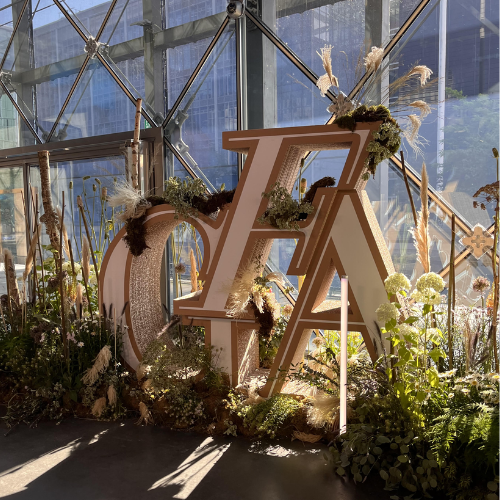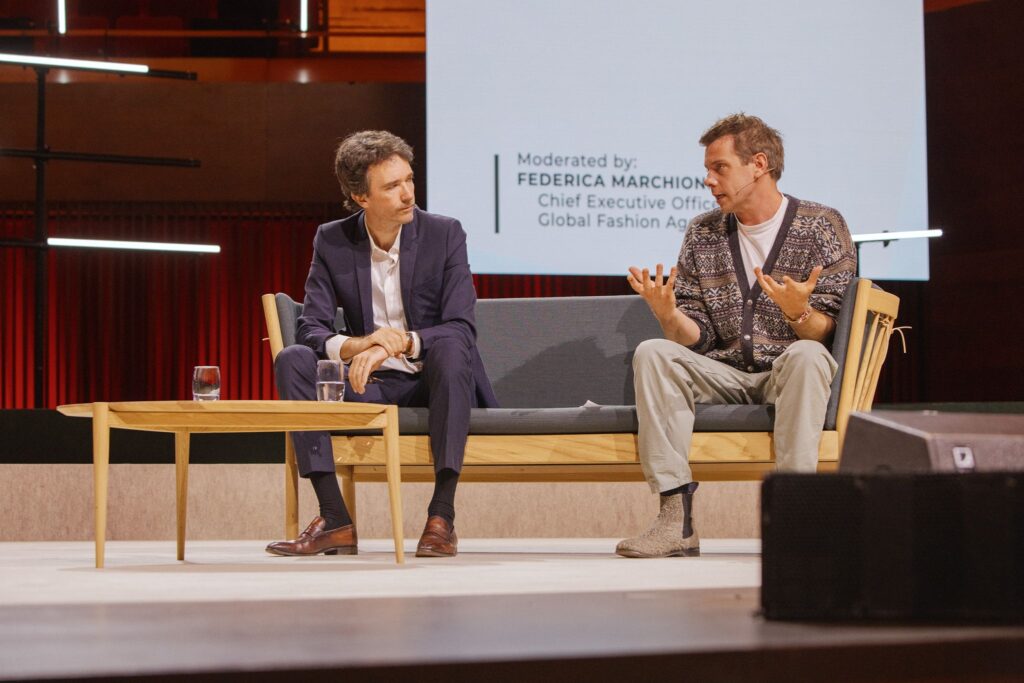On June 27th and 28th of June, I attended the Global Fashion Summit in Copenhagen with over 1000 fashion representatives of brands, NGOs, manufacturers, government officials, and more. The summit was organized by the non-profit organization the Global Fashion Agenda, who are “accelerating the transition to a net positive fashion industry.”
The theme of this year’s Summit was “Ambition to Action”, urging industry members to transform their goals and commitments into concrete action and take steps to improve sustainability on environmental, social, and governmental levels.
Many speakers took the different stages to discuss different topics regarding fashion and sustainability.
Here are my highlights of the event.
The Fashion Industry Is Not On Track
The message was loud and clear during the Fashion Summit: the fashion industry will not meet its sustainability goals at the pace it is changing.
The carbon emissions of the industry are still rising. Overconsumption is only expected to increase, and fashion brands produce billions of items yearly. The production of these items has a harsh impact on the environment, including, but not limited to, deforestation, pollution, and biodiversity loss. In addition, the industry lacks transparency, and many still earn well below a living wage.
Nevertheless, there was also hope and optimism. As CEO of the Global Fashion Agenda, Federica Marchionni said, “There is still a chance for change, but the window is closing quickly”. This statement was based on the IPCC report that came out this year, which found that we need to act fast in order to reach the goal of keeping the rising temperature below a 1.5 degrees Celsius increase. She further stated that the industry has the power to change, but we need to redefine the very essence of fashion, and we need to create a dialogue between policymakers in the industry.
The Development of Luxury Fashion
Several luxury fashion representatives attended the Global Fashion Summit, including Antoine Arnault, head of Image & Environment for LVMH Group, and Jonathan Anderson, creative director of Loewe and founder and creative director of JW Anderson. They discussed luxury’s sustainable development.
The luxury industry is the fastest-growing industry, but the question remains whether it is growing fast enough regarding sustainability and what type of action the industry takes. Antoine Arnault spoke on this and explained how sustainability has been at LVMH Group’s forefront for a long time. He stated, “Our philosophy is to be 100% honest even if the message is negative”. The Group has set many carbon goals, and instead of using carbon offsetting, they aim to reduce the emissions. In addition, it is highly important for the group to partner with specialists to create science-based targets. Moreover, he argued that luxury products are sustainable by nature because they are durable and bought to last for a lifetime. This statement caused a lot of uproar, as many did not agree.
On top of this, Antoine also cleared the air on their highly scrutinized decision not to join the Fashion Pact, an industry-wide initiative established by rivaling fashion group Kering. In their opinion, he stated that it was not the right thing to do as they would be associated with fast fashion brands.
Furthermore, moderator Federica Marchionni discussed how second-hand is important to have sustainability in fashion, but still, we see increasingly more fashion shows. Jonathan explained that this is indeed true but also highlighted how important fashion shows are for the business case of luxury fashion. He further explained that in order to incorporate sustainability in the fashion shows and Loewe’s stores, they are working with existing materials. So the furniture and art that is seen in shows were not made specifically for these shows. And if they were, these pieces would then be reused and placed in stores. In addition, the brand does not ship products worldwide to ensure that all stores look the same. Instead, they use materials from that country or area, which essentially also adds a nice twist to each store.
Governmental Representation In Fashion
The Global Fashion Summit also welcomed many governmental representatives to discuss the regulations necessary in the fashion industry.
The Global Dimension
During the panel ‘Policy Power: The Global Dimension’ Virginijus Sinkevičius, Commissioner for the Environment, Ocean, and Fisheries, and Dr. Anna Kelles, Member of Assembly, New York State Assembly, discussed the importance of regulations.
Virginijus Sinkevičius started off by stating how most challenges are related to textiles. The supply chain that we currently have is linear, which creates huge amounts of waste and should be circular instead. He explained how the design of products needs to change in order to make them less wasteful. He added to this that consumers also have a role in waste reduction. Virginijus Sinkevičius stated, “Design is not enough. It is just the first stage. As consumers, we have to change our relationship with clothes: go from fast fashion to a long-term sustainable relationship.” To this, he added that marketing also plays a huge role. “Green sells, but greenwashing is a huge problem”, he said.
We should expect more details on the proposed regulations in the coming months. The European Union is expected to introduce regulations that would ban the destruction of unsold goods and require brands to take back old clothes to recycle or reuse again. Moreover, label rules will be created to help consumers make better choices regarding sustainability.
Dr. Anna Kelles told a similar story for the US market and explained the steps of the due diligence of the OECD to “help enterprises identify risks relating to human rights, labor rights and the environment with a view to ending, preventing or mitigating those risks.”
Shifting the Narrative
Rachel Arthur from the United Nations Environment Programme and Danielle Magalhaes from UN Climate Change discussed the importance of communication for sustainable fashion.
During this panel, they revealed ‘The Sustainable Fashion Communication Playbook’. This playbook “provides a shared vision, principles and guidance on how to align consumer-facing communication across the global fashion industry with sustainability targets.” It helps fashion communicators like marketers, the media, influencers, etc., to advance to climate targets through “1) countering misinformation, 2) reducing messages perpetuating overconsumption, 3) redirecting aspiration to more sustainable lifestyles, and 4) empowering consumers to demand greater action from businesses and policymakers.”
Rachel Arthur explained that the principles for sustainable fashion communication are to lead with science, to change behavior and practice, to reimagine values, and to drive advocacy.
Rana Plaza
The Rana Plaza factory disaster happened 10 years ago in Bangladesh on the 24th of April in 2013 and was a significant event for systemic change in the fashion industry. This disaster killed over 1100 workers and highlighted just how unsafe and unhealthy the working environment in the fashion industry is. The catastrophe led to increased awareness and advocacy for labor rights, such as better working conditions, fair wages, improved safety standards, and increased transparency in the industry. Due to the effective safety campaign ‘the Bangladesh Accord’, Bangladesh has now the world’s safest, most transparent supply chain.
But what about other countries?
Moderated by Aditi Mayer, Miran Ali, managing director of the Bitopi Group, Michael Bride, Senior Vice President of Corporate Responsibility of the PBH group, and Joris Oldenziel, Executive Director of the International Accord for Health and Safety in the Textile and Garment Industry, discussed what is next in the international accords.
The aim is, of course, to get other countries to the same standards as the standards in Bangladesh. To achieve this, the panelist argued that collaboration is necessary. Right now, the fashion industry is very separated, and different actors rarely work together, but much more can be achieved by working together.
During the panel, it came to light that there are some voices still missing from the discussion. According to Miran Ali, that is the voice of the factory owners. According to him, so far, the decisions have been made using a top-down approach, with governments and fashion brands deciding what to do next, even though the factory owners need to implement these decisions and uphold the new standards. They are essentially the ones who end up paying for this transition.
In the transition to a more sustainable and ethical fashion industry, there should be equal decision power, and thus he argued factory owners should also have a voice.
Final Word
Overall, I noticed during the conference that the main argument that was made for increasing sustainability is to increase collaborations between brands, manufacturers, policymakers, and other important actors. I think that that is indeed an important aspect because it increases transparency and also spreads knowledge. Instead of seeing other companies as the competition, others could learn from them and see what they do right.
Essentially, systemic change starts by collaborating.
Still, there is so much that needs to be done to reduce the industry’s impact, and it is important to work towards circularity. Fashion companies have made many plans for sustainability, but it is time to actually put them into action and start walking the talk.
I am curious to see what improvements have been made when I attend the conference next year, and in the meantime, I will keep you updated with new innovations and fashion industry news.
In another post, I will discuss some of the organizations that had a stand in the innovation area.
Sources
The picture in the post is taken from the Global Fashion Agenda’s LinkedIn page. The link can be found in the picture.
The header picture is my own.





